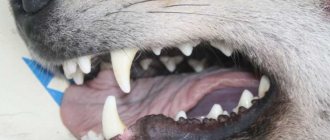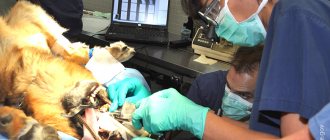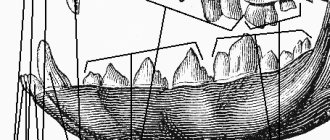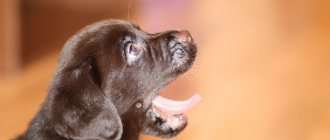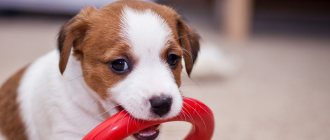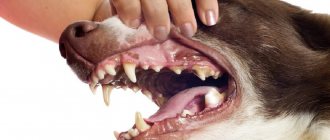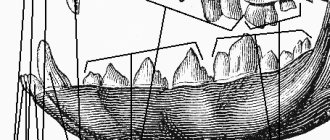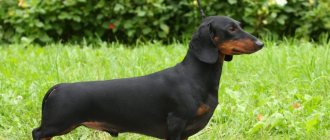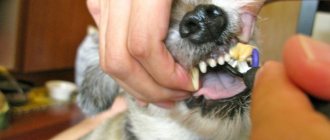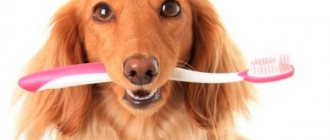The structure of the dog’s oral cavity plays a big role. The general condition of the animal and its life as a whole often depend on how it is developed. However, dog owners often do not know about this and have no idea how many teeth a dog has, and that they must certainly monitor the health of their pet’s mouth and carry out certain hygiene procedures.
We have developed this detailed article together with professional dog handlers and breeders for you so that you can properly care for your beloved pet. Therefore, it is worth reading for everyone who has a dog at home. And it doesn’t matter at all what breed.
Dog dental formula
The dog's permanent teeth have designations made up of numbers and various letters of the Latin alphabet.
The dog’s dental formula in the diagram looks like this:
- 2M 4P 1C 3I 3I 1C 4P 2M.
- 3M 4P 1C 3I 3I 1C 4P 3M.
Letters of the Latin alphabet - names of the type of clove:
- I – incisors.
- M – molars.
- C – fangs.
- P – premolars.
A dental formula is a diagram where a certain number can indicate the number of components, and a letter can indicate their type. The diagram is recorded in the order in which the dog's teeth are in the mouth. This method of recording dental patterns has been used for many years and during this time it has shown its effectiveness.
What happens if your pet loses teeth?
Even a significant loss affects the chewing process. In addition to unpleasant sensations and a high probability of complications in neighboring tissues, periodic problems from the gastrointestinal tract are observed. The whole point is that the food that gets there is poorly ground. Because of this, the stomach and intestines require more strength to digest it.
As a result of massive loss of teeth, the animal's bite is disturbed, which makes it unsuitable for participation in exhibitions. Such a pet has to be switched to soft and liquid food, which can cause new complications from the gums.
How many teeth does a dog have?
Structure
An adult dog has exactly 42 teeth in its mouth. However, sometimes there is a shortage or excess of chewing devices. The animal's carnivorous denticles are always normal. All predators known to us have them. These are quite strong devices that can easily grind any bones. They grow in dogs in the first year, gradually changing from acute milky ones to full-fledged permanent ones.
How many teeth does an adult dog have?
A dog that is over seven months old should not have temporary teeth in its mouth. A large dog has forty-two teeth: twenty on the upper jaw and another 22 on the lower jaw. You can even find out its exact age by looking at an animal's chewing devices. To accurately determine age, it is important to take into account the level of sharpening of the incisors:
- The front ones wear down a little at the bottom after a year and a half.
- Lower middle from below to - 2.5 years.
- Front on top - by 3.5 years.
- Average on top - by about 4.5 years.
- The last ones from the bottom - by 5.5 years.
- The last ones on top - by the age of six.
Puppy's milk teeth
Dogs are born into this world without teeth. At the beginning of the third week, their temporary teeth begin to erupt:
- Incisors grow at 4-5 weeks.
- The canines continue to grow for 3-5 weeks.
- Premolars in dogs grow in about 5-6 weeks.
Animals that are already two months old should have exactly 28 teeth in their mouth - fourteen on each jaw. When an animal is teething, it is important to understand how you can help her. It is necessary to buy toys that your pet can scratch its gums on. This way he won’t be able to spoil various things.
If the number of teeth is not normal
Not all animals, unfortunately, have the correct dental formula. Today, it is increasingly possible to encounter various deviations in the number of chewing devices, downwards or upwards. The exception is certain breed standards that arose directly during selection. Professionals specially raised them with such a dental apparatus and the number of chewing devices for specific purposes.
Reasons for possible abnormalities in dogs:
- Genetic inheritance.
- Personal characteristics of development and growth.
- Wrong diet.
- Deficiency of vitamin D, calcium and other elements.
- Injuries, illnesses and various metabolic disorders.
How does the change or eruption of teeth manifest?
Description of the change of primary incisors: from the 4th to the 5th month, the incisors, called hooks, fall out, then the middle ones and the edges. Then the first indigenous ones grow in their place. They are located immediately behind the premolars, which were not there before. They provide stability to the jaw so that the row does not creep apart. The canines finally change at 7-8 months. And then the molars grow.
In large breeds (at the withers they can reach 54 cm), replacement can occur somewhat faster than in small dogs. However, this process will in any case be completed by 1 year of life.
Note! Owners of small dogs will have to especially carefully monitor the process of loss, as well as the growth of new incisors. Baby teeth may not have time to grow, but molars are already forming and growing underneath them. It is recommended to periodically inspect the dog's mouth during the first year of a dog's life.
Teething is accompanied by slight discomfort in the form of itching. Your pet's gums will not hurt. To help your dog cope with this period, you need to provide her with special toys that will help relieve the itching. Tendon bones or edible treats such as cartilage are also good options.
When the puppy's first incisors grow, he may develop a fever. There is a risk of loss of appetite, apathy, and diarrhea. If one of the symptoms appears, you should consult a specialist.
Changing baby teeth to molars in puppies
Types of teeth
Dogs have three types of teeth, each with a specific function.
Fangs
Fangs are fairly long teeth. They are located directly between the incisors and premolar teeth. There are four of them, two on top and bottom, one on the right and on the left.
Permanent teeth
After the canines come the premolars. There are four of them on all sides. They are found on all jaws. Behind them the molars continue. There are molars on all sides.
Incisors
There should be six of these chewing devices on all the dog’s jaws. To the right and left of the special vertical straight line, which divides the pet’s entire jaw into two halves, there are hooks. Next come the middle ones, and then the edges.
Risk group by breed
The risk group includes small representatives of decorative breeds. With a normal dentition size, their jaw is more compact in size and has thin bone. Such animals include:
- Spitz;
- toy terriers;
- chihuahua;
- Yorkies;
- Pekingese;
- Japanese chins.
In addition to the genetic predisposition to the listed pathologies, such pets often suffer from persistence - an unusual anomaly in which both dentitions are preserved. This problem can only be solved surgically.
Appearance scheme
Chart of molars in dogs
Change in the appearance of molars:
- First, the animal loses its temporary incisors - the puppy is three to four months old.
- At six to seven months, the dog's fangs are replaced.
- With the fangs, all premolars fall out.
By nine months the process ends, and at the same time the dog’s radical bone formations appear.
Note. Representatives of small breeds are one to two months behind in terms of changes in the chewing apparatus.
Puppy's milk teeth
Small dogs live without teeth until the third or fourth week. Afterwards the temporary teeth erupt.
The appearance of milk teeth looks like this:
- Lower jaw: almost a mirror image of the upper.
- The dog's upper jaw: six incisors, two canines, six premolars - a total of fourteen teeth.
Associated symptoms that help determine the cause of the problem
If your dog has loose teeth, you need to pay attention to the accompanying symptoms. It is from them that you can make a preliminary diagnosis and understand how dire the current situation is:
- unpleasant odor, small holes, brown or black spots on the enamel – caries;
- sharp pain when biting, the presence of fistulas, swelling of the gums and muzzle - periodontitis;
- pain on palpation, chewing strictly on one side and refusal of cold food - pulpitis;
- increased salivation, redness of the mucous membranes and a brown-white coating on the tongue - stomatitis;
- bleeding during meals, the presence of small ulcers in the mouth - gingivitis;
- exposure of roots, leakage of pus and inflammation of the submandibular nodes - periodontitis;
- curvature of the bite, swelling and the appearance of blood from the mouth and nose - injury;
- the presence of suspicious growths in the oral cavity, sudden weight loss, oral bleeding - malignant neoplasms.
If you notice these symptoms, be sure to seek help. Tests will be required to determine the exact cause. Until this moment, you can only alleviate the pet’s condition by revising its diet to a more gentle one.
Caring for permanent teeth of an adult dog
A deficiency of certain microelements in food, as well as poor heredity, is a sure path to various diseases in your dog. Various diseases and the reluctance of animal owners to take care of the hygiene of their pet’s mouth predispose to all this.
The care procedure is necessary every day. If the dog is stubborn, you can do this twice a week. To do this, use a brush and paste. The procedure should be taught step by step: let the purchased paste smell, lift your lip, run your finger over the teeth. When the dog calms down and understands that there is no danger, you can calmly clean the outside.
It is best to carry out this cleaning after the dog is tired after a walk. In addition, chewing sticks clean the mouth.
Note. When cleaning the chewing apparatus, you need to talk to the animal to calm it down.
Disqualifying faults in huskies
Deviation from the standard parameters of the RKF is considered a disadvantage. The seriousness of the defect and the possibility of disqualification depend on the degree of its severity. The main defects include:
- Heavy and rough appearance of the head.
- A short or too long muzzle.
- Closely spaced or excessively slanted eyes.
- Large, widely spaced ears.
- Short, thick neck.
- Heavily furred tail in the form of a ring.
- Loose shoulder blades.
- Barrel chest with weak ribs.
- Clubfoot, thick fingers.
- Long, shaggy, coarse fur.
- Height is above 60 cm (for males) and 56 cm (for females).
- Overweight.
Bite in dogs
The bite is the position of the dog's jaws relative to each other.
Types of bite:
- Scissor-shaped. This is the correct type of bite. It is common for many dog breeds, since the lower jaw normally fits under the upper jaw. This bite is considered physiologically correct. It gives the dog the opportunity not only to chew food normally without injury, but also to make a fairly strong grip.
- Snack . In this case, the dog’s lower jaw protrudes forward, exposing the incisors and fangs. Can be considered the norm only in certain dog breeds with a short muzzle.
- Pincer-shaped . This type of bite is the norm for many dog breeds. In this bite, the lower and upper incisors are connected to each other, so the dog’s teeth become crowded together much more quickly.
- Underbite . This is a situation when the dog’s lower incisors and upper incisors are not connected at all, and the canines are tightly pressed to each other.
*** LABRADOR RETRIEVER PUPPIES in Bratsk ***
The structure of the dental system is an extremely important element of a dog’s exterior.
Teeth (dentes) are very strong organs that serve to capture and hold food, for biting it, gnawing and grinding it, as well as for defense and attack. Based on their function, structure and position, teeth are divided into incisors, canines and molars. The teeth are located on the lower and upper jaws, forming dental arcades or arches.
The International Canine Federation FCI has issued instructions on a unified designation system and teeth index values in order to avoid discrepancies in identifying and assessing teeth at international exhibitions. Teeth are designated by initial letters from the Latin name; the sequence in the numbering of indices in all groups of teeth is the same, i.e. from the middle of the jaw in both directions and from front to back.
Teeth are divided into incisors, canines, and molars.
Incisors (dentes incisivi) - located behind the lips, three on each side, designated by the letter I.
Among the incisors there are:
- hooks - the very front teeth, the right and left hooks are next to each other,
- middle incisors - stand immediately behind the hooks,
- edges - the farthest of the incisors.
Fangs (dentes canini) - placed behind the incisors, one on each side on the upper and lower jaws, designated by the letter C.
Molars are divided into premolars (or premolars) and molars (molars).
Premolars (dentes premolares) - located behind the fangs in the amount of 4 on each side on each jaw, designated by the letter P.
The last group of permanent molars (dentes molares) follows the premolars, 2 pieces on the upper jaw and 3 pieces on the lower jaw; denoted by the letter M.
A complete set of teeth for an adult dog has the following formula:
— incisors I = 3/3;
— fangs C = 1/1;
— premolars P = 4/4;
- molars M = 2/3.
Therefore, a complete set of permanent teeth in an adult dog consists of 42 teeth.
Just like a person, a dog's teeth change once in a lifetime. The first teeth are called baby teeth (dentes decidui). They begin to erupt at the beginning of the puppy's fourth week of life. Around the end of the fourth month, baby teeth begin to fall out. In the sixth or seventh month, tooth replacement ends. By the age of 1.5 years, the teeth are already fully formed.
A set of primary teeth consists of 32 teeth (some authors consider 28 teeth). Each half of the puppy's jaw has 3 incisors, 1 canine and 4 premolars, for a total of 32 teeth. Milk teeth differ in appearance from permanent teeth; they are smaller and thinner, looking like needles. Primary teeth are characterized by a very tight fit to each other, but with age, as the jaw grows and enlarges, the gaps between the teeth increase.
Puppies are born without teeth. The incisors appear first, around the fourth week of life. And in the third month they begin to wear down and stagger. Initially, the internal incisors (hooks) fall out, then the middle incisors follow, and in the fifth month the lateral incisors (edges) are replaced. Primary canines are usually replaced by permanent canines at 6 months. Primary premolars grow in between 4-8 weeks, with the exception of P1, which usually grows in when the dog is 5-6 months old. P1 - the first molar grows only once and is immediately permanent. Molars, the back molars, grow only once and therefore never change. They should grow by the end of the 7th month. Baby teeth begin to fall out as permanent teeth grow, which gradually grow and at the same time put pressure on the roots of baby teeth. Due to this pressure, teeth become loose and fall out.
The structure of the tooth includes the crown, neck, root,
The crown is the part of the tooth that protrudes from the dental alveoli above the gum surface. The shape of the crown is different for different teeth: for incisors it is wedge-shaped, for canines it is cone-shaped, and for molars it is tuberculate.
The roots of a tooth, numbering from one to three, are located in the dental socket of the jaw, in which they are strengthened by connective tissue - periodontium. Single-rooted teeth include incisor canines and first (1st, 2nd) premolars. The root of the tooth is covered with bone tissue - cement.
The neck of a tooth is a narrow transition from the root to the crown. The gum is attached to the neck. The basis of the tooth is dentin, a special calcified connective tissue. In the crown area, dentin is covered with very durable, highly calcified epithelial tissue - enamel.
The correct functioning of the dental system is possible only if the teeth are located relative to each other in a certain order. The mutual arrangement of the teeth of the upper and lower jaws is called the bite. Only a correct bite allows the most productive use of physical efforts for mechanical processing of food in the oral cavity.
There are four main types of bite:
- scissor-shaped,
- pincer-shaped or straight,
- snack,
- undershot.
Most traditional dog breeds have a scissor bite, typical of the wild type. With this bite, the incisors of the lower jaw adjoin the inner surface of the incisors of the upper jaw, and the canines of the lower jaw fit into the spaces between the edges and canines of the upper jaw, and the sliding surfaces of the canines of the upper and lower jaws have a minimum gap between them.
Pincer bite (straight) is characterized by the closure of the incisors of the upper and lower jaws end to end, like in pincers.
Underbite occurs when the lower jaw is relatively shortened. With this bite, a gap appears between the sliding surfaces of the incisors. Underbite is often complicated by the occurrence of inclination of the incisors and partially canines. In this case, the inclined position of the roots of the incisors and canines can be observed on the radiograph.
An underbite (“bulldog” bite) is really typical for bulldogs, boxers, bullmastiffs, and pugs. With this bite, not only the lower incisors, but also the canines protrude beyond the line of the upper incisors. The overbite can be tight, in which the gap between the upper and lower incisors is minimal, or with a departure, in which there is a more or less significant distance between the incisors.
Numerous studies by breeders show that the shape of the bite is largely hereditary. Anomalies in the dental system may indicate a dog’s possible homozygosity not only for the genes for this trait, but also for many other alleles, which may almost certainly include genes that cause general weakening of the body and loss of constitutional strength.
Much attention is paid to the problems of full teeth in dogs. For some breeds, having a full set of teeth is absolute. For others, the requirements are somewhat relaxed. Congenital dental anomalies include: an increase (polyodontia) or a decrease (oligodontia) in their number, anomalies in location, shape and structure. Such phenomena as oligodontia and polyodontia can be diagnosed both at the time of litter activation and after the change of teeth.
Poly- and oligodontia have been found in all types of domestic animals, and the genetic cause of these anomalies has already been proven.
The following main mechanisms of their occurrence are distinguished:
1) splitting of the tooth germ;
2) fusion of tooth germs;
3) development of an additional tooth germ in the dental plate;
4) the absence of one or more rudiments in the dental plate.
Incisive oligodontia can manifest itself in different ways:
- teeth are of normal size, but their number is less - four or five instead of the required six;
- two teeth grow together from the roots to the top of the crowns, forming one larger tooth of normal shape. If this happens on one side, then five teeth grow, and if on two sides, then four;
- the two outer teeth grow together with their roots, the crowns of the teeth are separated by their apices. A so-called double tooth is formed.
Polyodontia occurs in a typical or atavistic form, which is characterized by the presence of supernumerary teeth inside the dentition and which is almost physiological and atypical, when supernumerary teeth grow outside the dental sockets, sometimes even outside the oral cavity. Pseudopolyodontia is most often associated with retention of primary teeth. Supernumerary teeth may appear as a double tooth. Polyodontia is often a consequence of thyroid deficiency. Some breeds have an increased incidence of polyodontia on the incisors. For example, the standard dachshund periodically produces individuals with seven upper incisors. Similar cases have also been reported in German Shepherds and Collies. It is important that the size of the teeth corresponds to the size of the jaw, which largely guarantees their correct location in the dentition - without the development of misalignment. Sometimes in dwarf and toy breed dogs the teeth are too large in relation to the jaw and cannot be arranged in an even line, which leads to the so-called misalignment. Disorder may also be associated with underdevelopment of the lower jaw. As experience shows, the degree of hereditary conditioning of disorder is quite high. In some cases, there is a so-called misalignment, which manifests itself in the inclination of the dentition in a certain direction.
Deviations in teething are often observed, when permanent teeth erupt while milk teeth have not fallen out, and a double tooth is formed, most often a canine, or even a double row of teeth. Such anomalies are characteristic of disturbances in the activity of the pituitary gland - thyroid - parathyroid gland system, which also occurs when the genome is unbalanced.
A careful examination of the dental system sometimes reveals an abnormal approach of the roots of the teeth - root convergence. With this anomaly, the pressure produced by the roots of the teeth does not dissipate on the jaw tissue, but on the contrary, strong local pressure arises, which over time leads to trophic disorders in the gums and surrounding tissues. Divergence of the roots, or otherwise divergence of the crowns, occurs during the period of replacement of baby teeth as a result of a delay in their loss and leads to the development of rare teeth.
Another type of dental anomaly is tooth retention, in which the tooth is not in the dentition, but in the thickness of the jaw bone.
The shape of the bite and any deviations from the complete dental formula in most cases are determined by the polygenic system, which can be considered as an indicator of an unsuccessful combination of gene blocks in the genotype, which can lead to multiple undesirable consequences. It is advisable to exclude carriers of these anomalies from breeding.
1. Akaevsky A.I., Yudichev Yu.F., Seleznev S.B. Anatomy of domestic animals - M.: Kolos, 1984. - 543 p. 8 l. ill.
2. Blokhin G.I., Gladkikh M.Yu., Ivanov A.A. and others. Cynology. Textbook for universities - M.: LLC Publishing House Scriptorium 2000, 2001. - 432 p. with ill.
3. Gusev V.G., Guseva E.S. Cynology. A manual for experts and owners of breeding dogs. – M.: Aquarium-Print LLC, 2006. – 232 p.: ill.
4. Zelenovsky N.V. Anatomy of a dog. – St. Petersburg: Law and Management, 1997. – 340 p.
5. Ierusalimsky E. L. Dog exterior and its assessment - M: PUBLISHING CENTER, 2002. - 195 p.
Problems in dogs
Different breeds of dogs can have quite a few dental problems, but two of the most common ones are worth highlighting.
Malocclusion
This problem in an adult dog is difficult to correct, so it is advisable to take care of this from the pet’s childhood.
It is important that his diet is complete. It is necessary to look at the various marks on the packages. The food should be intended for puppies, as it contains a normal amount of microelements and vitamins. When choosing food, it is important to focus on its overall quality.
If you feed puppies natural food, do not forget about purchasing a complex of minerals and vitamins. Your veterinarian will help you choose the correct dosage and required composition.
This problem is fraught with diseases of internal organs, which is why it is so important to contact a veterinarian in a timely manner. He will assess the condition of the animal’s mouth and make recommendations. If necessary, a brace system can be installed.
Note. The time to contact a veterinarian in this case is limited - five to twelve months.
Gum inflammation
Gingivitis leads to loss of the masticatory apparatus, as well as blood poisoning. The animal wants to eat, but cannot do so due to severe pain. Constantly whines - there are ulcers with pus in the mouth, saliva flows heavily. The main reasons for the appearance of gingivitis are a change in teeth, various allergies, a deficiency of some vitamins, or tartar.
How to help your pet?
When changing teeth, the puppy behaves like a small child - he puts everything in his mouth. He needs this not because of his bad character, but in order to relieve the itching in his gums, where new teeth will soon appear. During this period, interior items, the owners' shoes, wires, everything that comes into his field of vision suffer. Sometimes this can be unsafe. Therefore, the puppy should be weaned from gnawing anything, as the teeth will grow, but the bad habit may remain forever. To do this, the puppy should be allowed to chew on what is good for him - whole apples, carrots, special dog bones and crackers. This simultaneously cleans your teeth and relieves irritation from your gums. The pet also needs to be provided with toys that it will be allowed to chew.
When to contact a veterinarian
Frequent dog diseases that, unfortunately, cannot be dealt with on your own:
- Stomatitis is a problem with the oral mucosa.
- Caries is a disease of tooth enamel.
- Periodontitis is a disease of the tissues directly around the tooth.
- Tartar is the appearance of hard plaque on the teeth.
- Pulpitis is the presence of a large amount of pus directly in the root canal.
The dog's teeth break regularly. This happens due to a deficiency of beneficial microelements or vitamins in the diet, injury or severe pressure.
Gingivitis is inflammation of the gums. This disease causes many problems - the dog constantly whines and is unable to eat.
Another problem that requires veterinary help is malocclusion. It may occur due to abnormal development of the denticles.
Possible complications
- Malocclusion
Dogs with long muzzles often face malocclusion problems. They have regular-sized teeth growing on narrow gums. Also, the cause of malocclusion may be teeth changing out of order or a person interfering. To avoid this, it is necessary not to suddenly tear objects out of your mouth during games. If an abnormal bite is found in an ordinary domestic dog, then nothing is done about it and left as is. If the problem occurs in a show dog, this is a big disadvantage. In this case, special braces are placed under anesthesia and the bite is leveled.
- Gum inflammation
A slight inflammation of the gums does not leave the puppies throughout the entire period of changing teeth. The gums become reddish and swollen, and salivation increases. Appetite often decreases due to pain in the gums. This process generally does not require assistance. The only thing you should do is give up rough food so as not to injure your gums. If you notice any complications, it is better to contact your veterinarian. The doctor will prescribe medications to sanitize the dog’s mouth.
- Delayed tooth change
It happens that baby teeth have not yet fallen out, but molars are already growing in their place. This can lead to malocclusion, as well as unnecessary damage to the cheeks and gum inflammation. If you notice this case in your pet, then you should try to help the baby tooth fall out at home. If unsuccessful, you need to take the dog to the veterinarian so that he can remove the tooth under anesthesia. If this is not done in time, you will eventually have to undergo surgery.
Dog's age by teeth
According to many experts, a dog’s age can be determined directly by its teeth:
- By the age of 1.5 years, the lower front incisors of dogs of different breeds become dull.
- By 2.5, the middle incisors from below begin to wear down.
- At 3.5, the upper front incisors become blunt.
- At 4.5, the top middle teeth become blunt.
- At 5.5 years old, the last lower incisors become blunt.
- At 6.5 years old, the last upper incisors are ground down.
- By 8, the fangs become dull.
- By age 10, a dog’s front incisors become oval-shaped, and by age 12, they fall out.
- Before the age of sixteen, any dog loses all its other teeth.
Note. Depending on the conditions in which the dog is kept, the abrasion and loss of teeth may occur faster or slower.
Husky show standards
According to unified criteria and standards from RKF, a husky must meet the requirements:
- have average sizes;
- proportional physique;
- erect triangular ears;
- neck of medium length, moderately arched;
- slanted eyes of brown, blue or different colors;
- black or light nose;
- strong and deep chest;
- well-furred sickle-shaped tail;
- straight limbs;
- double layer wool cover.
Number and location of teeth
The number of teeth may vary slightly depending on the type of dog. On average, the cavity contains 42 pieces. There are 20 pieces in the upper part, 22 on the lower jaw.
The arrangement of a dog’s teeth is conventionally divided as follows (if you mentally divide it in half):
- The upper part - 3 incisors, 1 canine, 4 false roots (premolars), 2 molars (molars) - in the left and right zone.
- The lower part is exactly the same, but there are more molars - 3 each.
You can consider the anatomy of the location in more detail in the diagram below.
The number and types of teeth should be almost the same in all breeds
